Text
what would go into my assessment if i could fit it (too many words)

Hird, Rose. maumahara. 2023, Private Collection.
My work maumahara is a piece of art that reflects my learning about Matariki. Through my research I discovered Mahi Whai, a way of passing on and connecting knowledge to imagery, especially undertaken by children. I considered this and thought of matching the pattern to the stars as a way of remembrance, maumahara. Through using a traditionally craft medium such as multi-block woodcutting I am making links between the renaissance of both Matariki and the recognition of printmaking as an art.
0 notes
Text
week 6 presentation
some tiny notes from what people said about mine!!
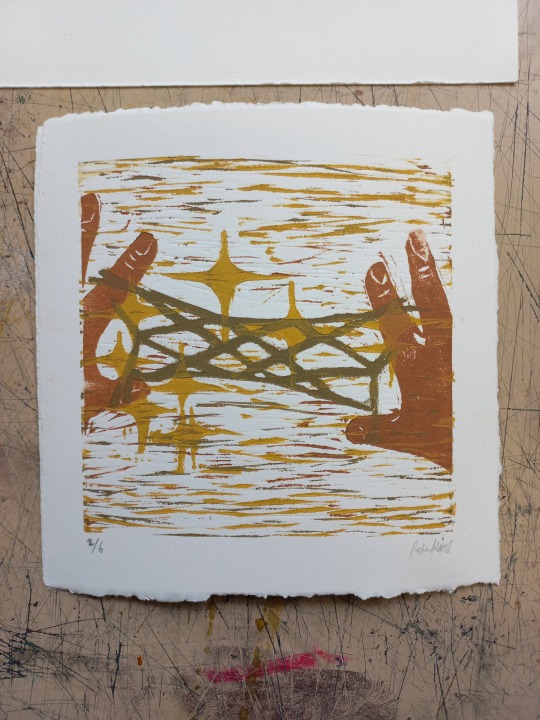
catherine didn't tell us until most of the way through that we had to make notes and I also forgot to as well. anyway here is an image I took of some of the things that the others said. The one major thing I got from it was probably more questions on how I made it rather than what the work is about. printmaking is a dying art form that I aim to revive!! oh lots of people also said they really liked the colours i used!!
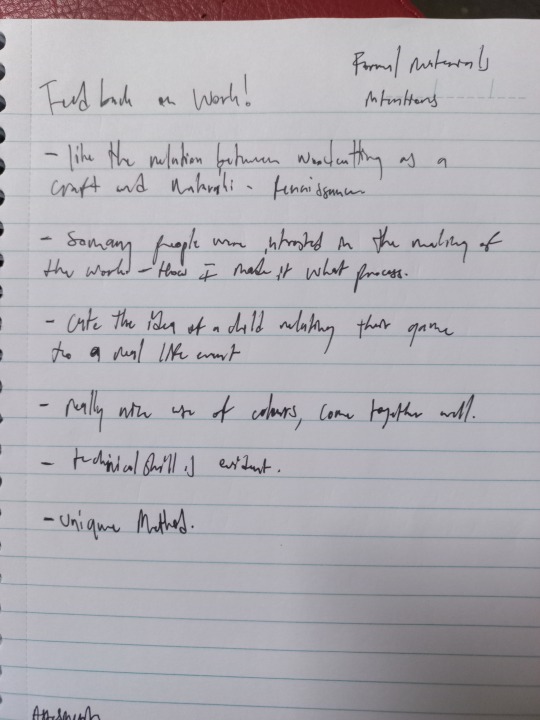
notes from crit /\
we had a chat beforehand saying about how we want the space to work in order to make it good/safe so we all felt like we could share. some of the things I recall from that list were;
make the space informed (do we have to say anything about the work)
presenting to a small group of people
actively listening
introducing ourselves and pronouns
uplifting one another
giving sound and reasonable critisim
saying what we like about the work beyond 'liking it'
give time to speak
ask informed questions
that is all i can remember but there was more.
my intentions/final thoughts about the piece.
we were posed three things to make sure we shared when talking about the work
my topic of choice was matariki! I didn't really know much about the cluster of stars or the holiday so I wanted to use this class/assignment as a way to do some research and find out some more info (go a little deeper). So through researching I found this method of preserving/passing on knowledge called mahi whai (also known as cat's cradle) which I can recall doing in primary school!! anyway i was really drawn to it as a way of preserving knowledge and sharing a story/remembering a legend as such. I thought it would be an interesting idea to like think of a child being entertained by playing with their string as they woke up in the early morning to join their whanau in viewing matariki. they could compare their strings and patterns to the stars in the sky and realise the real life reference to their game. so I compositioned the piece to look like such! upwards looking/view of the string to see the stars.
I used a method of printmaking known as multi-block relief printing using woodcutting as my chosen method (i have never used linoleum and am afraid to). Mostly because for the idea I had reduction woodcutting wouldn't work as I needed multiple elements to overlap and interact and reduction printing will not work with that - also i don't really need shadows or anything so just having multiple blocks is better!! anyway qualities of the print is like using a process such as relief printing or printmaking generally can bring up connotations with crafting and craft mediums (as printmaking has been used in history for book making and other kinds of commercial printing it is not very popular as a fine art or a way of making art). because of the commodified nature of printmaking it isn't always viewed as an art and therefore i am in a way referencing the renaissance of matariki as a nationally recognized public holiday and printmaking as a fine art. making connections to how both are viewed under their historical context.
I have already outlined some of my intentions so i dont think there is much else to say other than i really enjoy printmaking so I wanted to use this medium for my crative component.
0 notes
Text
week 5 notes on references
gna put some notes in about my chosen references!!
how I expand my learning by contextualising the quotes i have chosen!! / why i might use the quotes
Quotes to use ??;
“Science throughout its history has had a complex relationship with seeing things. If I were searching for a way of trying to grasp at its most fundamental level just what kind of activity science was, I think that thinking about science in terms of seeing would be a very good place to start.” - how they view the stars to then relate to planting etc.
Science reading iwan morsys
How does it relate to the world around us? - could use to help explain how matariki relates to the world around. Maori use matariki as a signal to plant crops, look to each of the individual stars to decide what could be a better harvest in the coming months etc. Use matariki for navigation - would honestly work better as a quote for matai arorangi though probably rather than matariki.
"Perhaps this is because it took conventonal Western science up untl at least the later half of the 20th century to fgure most of this out, and we like to believe that Western-style science is the most advanced of all. So how did the old people do it? Of course, I can only guess. I see the advantages in being ‘stone-age’ – that in the evenings, you only had the night sky to look at, and stories to tell. That over generatons, stories built upon older stories, certain people with partcularly clear vision saw paterns in the night sky, or notced movements, a distant star going supernova perhaps, or the blinking out of light from a long dead sun. It is possible they looked inward as ofen as out, travelling the complex pathways of the mind and spirit, touching ancient wisdoms about our origins only dreams can ofer. And, in the darkness with only natural light from the milky way to see by, they began to understand what lay behind the stars, what went before them, the place of potental, Te Korekore, with Io twitching into life. "
“That is a story, and what is important about it is not that we believe it is true, but that we understand what it stands for.”
Twitch Tina Makereti
two different quotes from tina makereti that i could use??? I would paraphrase/shorten the first quote by taking out bits that I do not need /dont relate to what I am writing about/to reduce my word count so then I can just talk about how maori used matariki to search for knowledge about navigation and crop growing and remembering their family etc. good to help ground/bring in the idea through using the quote. im pretty certain tina's second quote is talking about the creation of the world (and what maori believe about it) but i think it could also be used in the context of matariki, matariki stands for connection and rememberance which in some ways are deeper and more important than the other things we use matariki for (crop growing, navigation) at the end of the day you only have each other and in the society of today that is so rushed I think it's much better to highlight this point and bring it to the forefront rather than any other ideas associated with matariki.
"We’ve orientated our entire world and our entire… cycle to fit into the northern hemisphere. Why do they celebrate New Years in the middle of winter and we do it in the middle of summer?"
This is kiwi rangi matamua
good little one sentence to use to go into the maramataka, doesn't really explain much about the calendar system but can be used to go into it - also like using dr rangi matamua because he advised the government on it and I was really drawn to the podcast episode about this.
‘Ngā Mata o te Ariki Tāwhirimātea’ (The Eyes of Tāwhirimātea)'
a video that helps to explain this quoite and expand my learning!!
a video on the myth/legend of tawhirimatea so I know what it is in case I want to use it in my description. (maybe) just in case i want to go into the myth side of matariki - although this is just one myth about it there are many different from all the different tribes around nz. I feel it's also just good to have a direct quote/reference to what matariki fully stands for from another source on stream so that I can tick the using multiple resources box off.
“I understand that there are tribal variations and differences, and that's awesome. It's meant to be different because we're different. I really support the coming through of traditional regional variations. My version has nine stars, because I can only go off what my ancestor says. If you have seven, have seven, if you have Puanga, have Puanga. And for Pākeha, accepting that has been a lot better, but Māori, we can get pretty territorial about stuff, like 'that's not what we believe'. That's the bit that makes me hōhā because that's not the point. The point is we celebrate it.”
would paraphrase to explain how different tribes believe in different things relating to matariki - then could use to explain the holiday and people's response to it becoming a national holiday in nz!! could then use the bit where he says the point is that we celebrate it and add/uplift it by also using tina makereti's quote about how it's important that we understand what a story is for??
0 notes
Text
Week 5 making
WRITING and MAKING: Continue self-directed work on your assignment. Complete your practical work to bring to class next week and continue refining and revising your writing if needed.
images of my making of my work!!!
As I previously mentioned I have decided to make a multiblock print using woodcutting, one thing I have realised since starting my print/cutting I think my tool is quite blunt so all the imagery has come out not quite how I would've liked, had to do many recuttings as I printed because they weren't deep enough. anyway tool is not sharp and that made it a bit hard to get finer detail in.

my unprinted blocks and the pile of shavings made from it.


colour mixing and testing on the paper colours!! I want to note that I used yellow ochre in all of these colours as one of the main ones. Also, I tried to make the yellow really nice and bright but I think either my brayer had dark ink on it or the ink oxidized because it came out more ochre-y than I would've liked, otherwise the colours look really good together because of using the yellow ochre in all of them. oh the ink could've also changed because of the dark pencil (6B) i used to draw my lines to carve into my print.
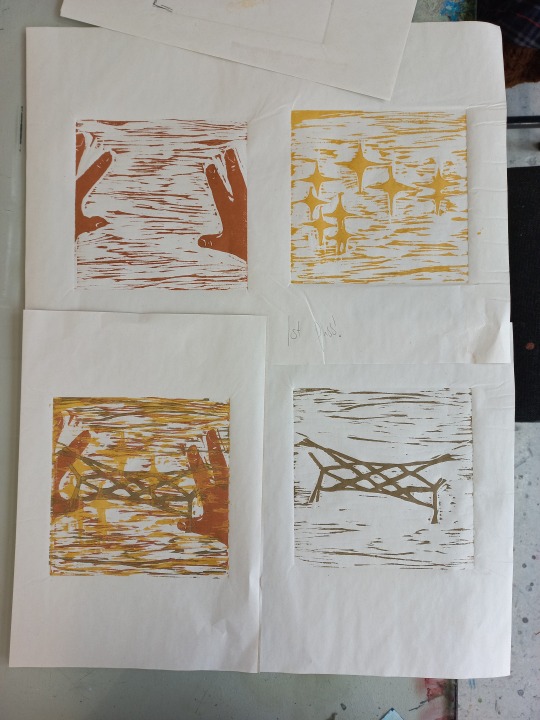

pressure testing and testing to see what will show up. Tests are done on newsprint so colour is not true to the off-white that my proper/nice printmaking paper is. Hence the yellow looks so much more brilliant here than on real paper. With adding more and more ink I noticed that my shapes were bleeding/losing some of their shapely-ness. I think I didnt give myself enough space to make sure the ink on my brayers was thin enough which also contributed to most of the problems I faced (I think)

After doing some thinking I thought that maybe I wouldn't use a background because I 1. liked the negative space/white in the prints 2. it wasnt the right size and I didnt want to spend ages testing to get everything to come through. 3. colours didn't look good when layered with the blue. SO i decided to use only 3 blocks rather than 4.

final 6 prints on REAL paper looking at these you can see where I cut the lines back and then reprint and then cut again, you can also see where there is too much ink and it began filling the lines of my print (look at finger nails) my bad for not thinning it out more! then looking at all these I decide which one will be the one I present - which is something I love about printmaking, I can just decide which ones I like and don't like and then use the best!! rather than only being able to work on one thing at a time.

the leftovers of my inks (notice not much space) and very thick
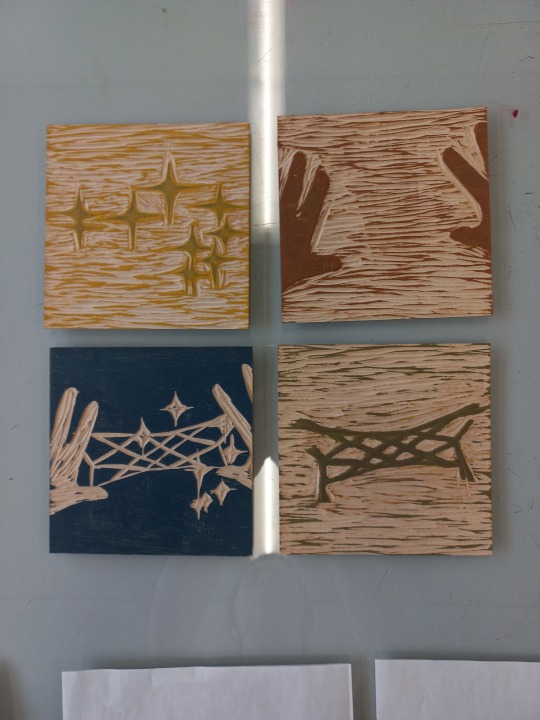
my final block prints!!! can see because I was applying too much pressure when inking the blocks where the lines are (where i had tried to cut them out 100's of times as well)

final chosen print !! 2/6, ink hasn't filled the nails, the string is off centre (I think my plates were not the same size oops- I am incapable of being able to measure things right). Also like this one because it has the most empty space.
Titling the piece, thinking about what matariki stands for and what specifically the art of mahi whai is about/what it aims to share is about remembrance. Remember the story of the whetu through mahi whai, remember the lost ones through looking at the stars etc. I will do some research into maori words for remembering and I may use one of those!
maumahara
1. (experience verb) (-tia) to remember, recall, recollect, reminisce.
0 notes
Text
week 5 self-directed
something STUPID has happened!!!!!!!
so the webpage for my chosen artwork (mountain jade) has deleted the original page !!!!! (WHAT THE ABSOLUTE HELL)
after asking holly and also my mentor on studiosity about how I should refernece this I decided to just add a note about how they could be messed up both here and in my actual writing because I am so concerned that it will not work and you will never find where i got my info from.
so i have contacted both the company and also used the way back machine to extract the info and hopefully i will get the original image off of the company too!! weird as but I am super pleased about it!!
way back machine link
original mountain jade link (this use to link to what the way back machine link now links to) takes a couple of reloads to get through
https://www.mountainjade.co.nz/404
here is my emailing with the people !!! to get the original image - i dont quite know how I will reference it though kind of super confused
our email exchange!! (I got a response from mountain jade almost immediately after sending them a message which is pretty cool)

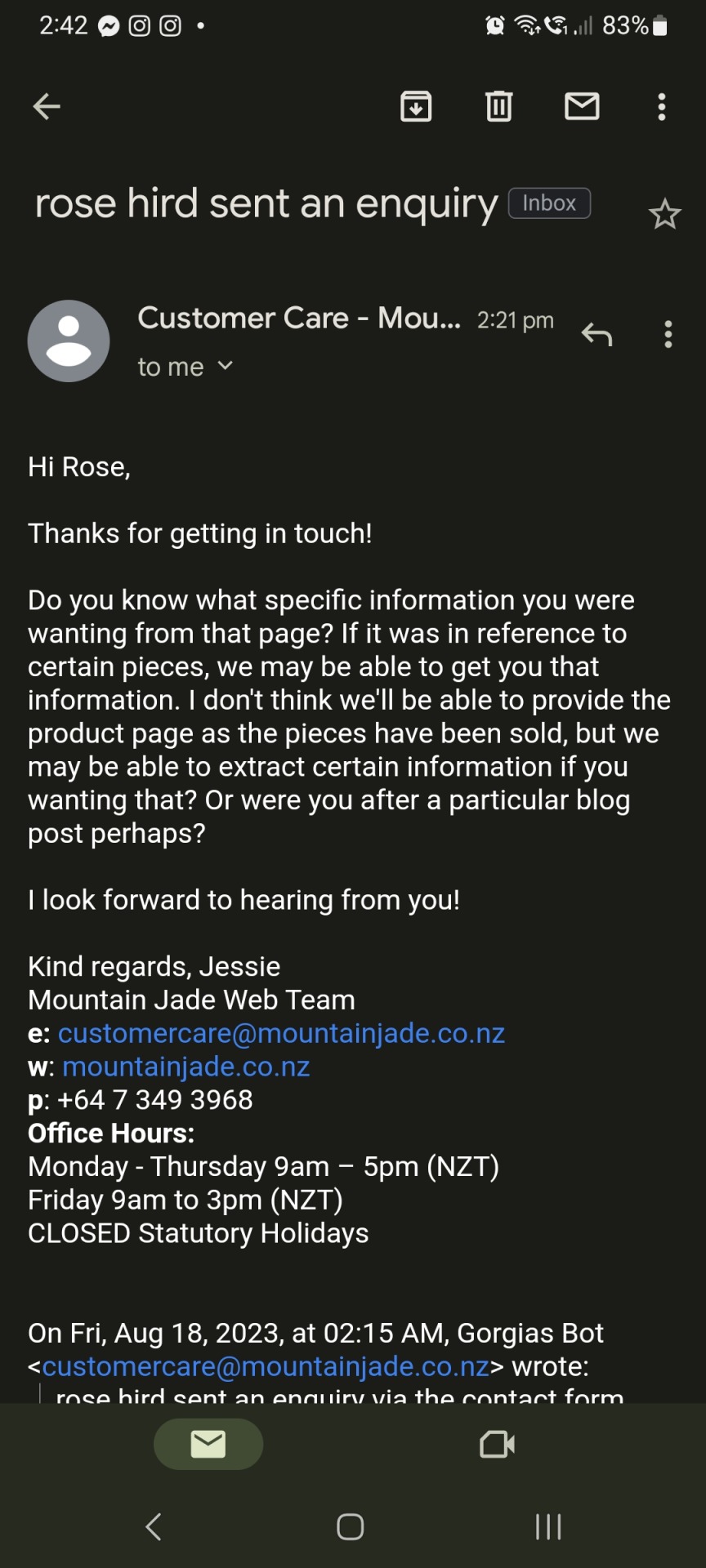
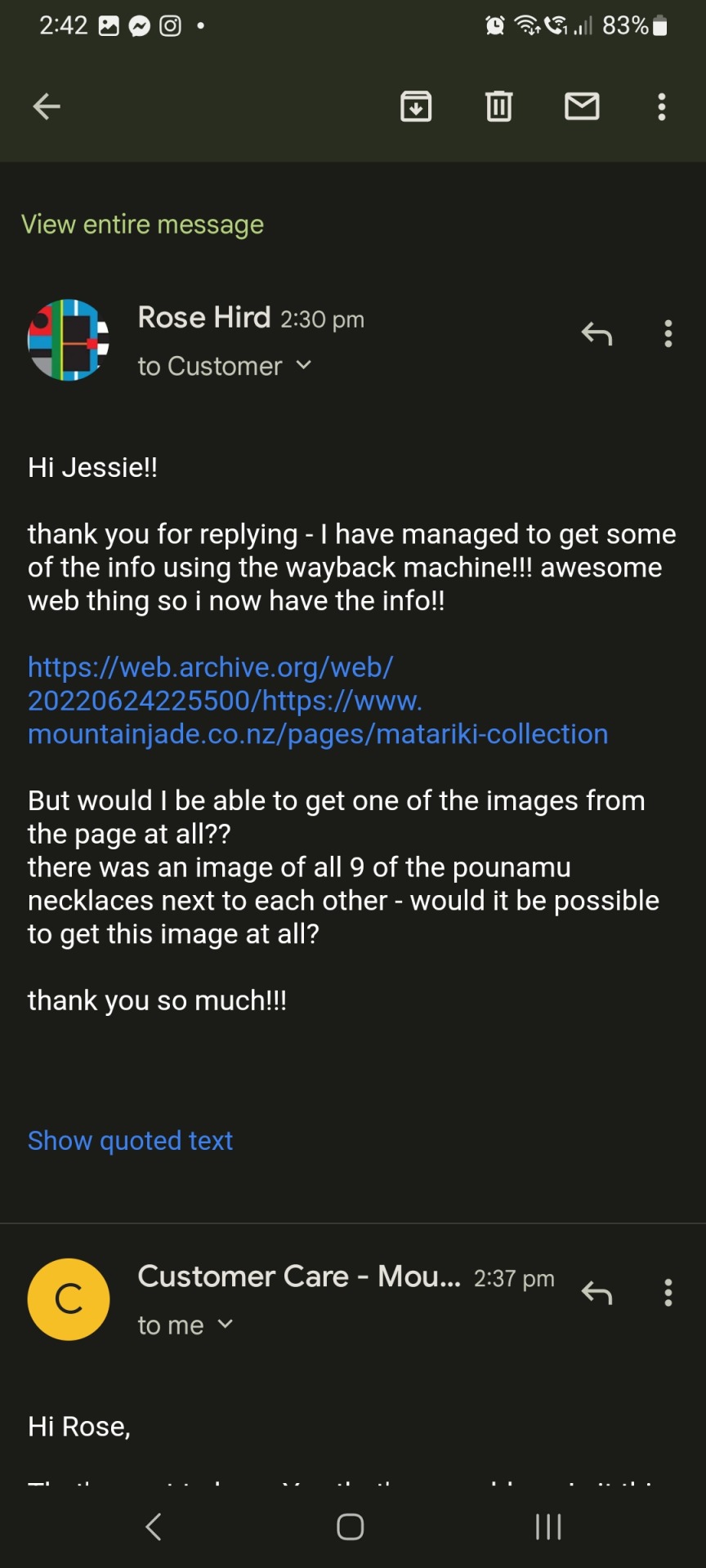

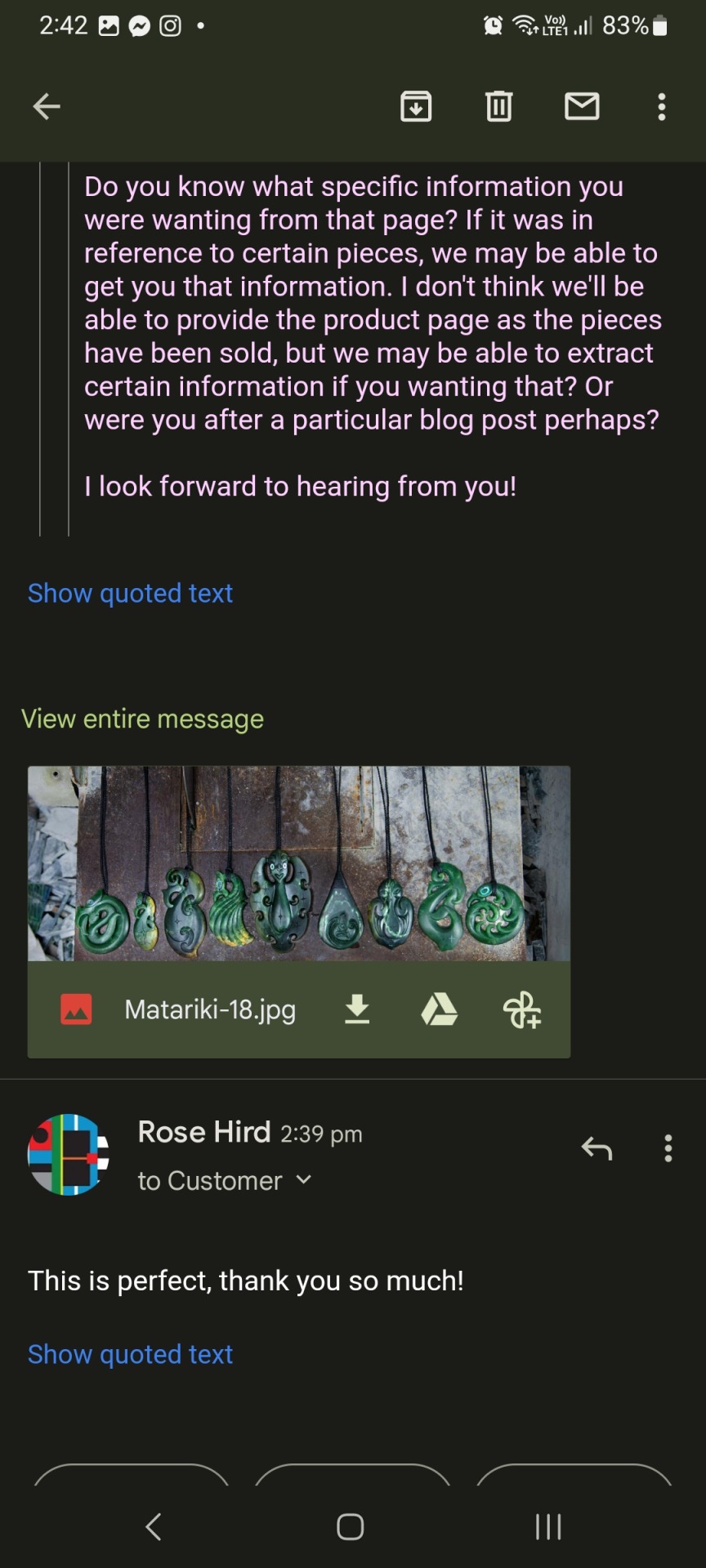
0 notes
Text
week 5 independent
Task 1 (5 minutes)REFLECT: Have a look at your responses to the independent study from last week, how did this weeks class discussion deepen or help develop and expand your initial understanding? You could write about this in a sentence or two, or you could go back and add to your original notes.
well, we only did one of the things last week (tame iti not Kaye-Maree Dunn) so in terms of my learning on that I don't have much to expand on. It's really interesting to have the phrase post colonial be discussed because I can recall in English class talking about post colonial literature but realising now there is none, because colonialism still exists in many forms in our systems and institutions so it can't be post it can only be during. I just spoke to my flatmate today about how I also don't believe any colonised nation treats their indigenous people as the real first nation people. they are secondary - which in a post colonial world would mean everyone is equal. equity not equality. It's interesting to also hear thoughts from another maori man who is not speaking from lived experience (well not only) but also from a history standpoint of colonialism and decolonisation in Aoetearoa.
Task 2 (4 hours) Self-directed study on your first assignment
WRITING and MAKING: Continue self-directed work on your assignment. Complete your practical work to bring to class next week and continue refining and revising your writing if needed. Compile your reference list (make sure all the sources you have cited and/or quoted in your writing are included in your reference list). Use the Massey OWLL site to check your citations and reference list formatting. You will find the link to the OWLL site and the MLA 8 document in the Assessment information and Drop-boxes section.
NOTE: You will need to bring a print out of your assignment work to class next week.
ANOTHER DRAFT;
Matariki - short for Ngā Mata o te Ariki Tāwhirimātea’ (The Eyes of Tāwhirimātea) (Māori creatives on what Matariki means to them par. 9) is all about coming together to celebrate. We celebrate our world, our home and our people. We celebrate who we are and the year that has passed during this time. Mourning those who have passed in the year before by shouting their names as the first whetū rises. The rising of the star cluster of Matariki signifies the beginning of the new year according to the maramataka. Dr. Rangi Mātāmua raises an interesting question on our calendar; “We’ve orientated our entire world and our entire… cycle to fit into the northern hemisphere, why do they celebrate New Years in the middle of winter and we do it in the middle of summer?” (13:31). Aotearoa is on the opposite side of the world yet we celebrate everything at the same time as in the northern hemisphere, we have our longest holidays when it’s the middle of summer and traditionally planting, harvesting, fishing and foraging would be at its height.
Explain quote

Walker, Tamaora. Scally, Akapita. Matariki Collection. 2022, Mountain Jade Rotorua.
The artwork I have chosen is the Matariki 2022 collection from Mountain Jade. Made in collaboration by brothers Tamaora Walker and Akapita Scally. Using pounamu they have created different taonga which represent each of the nine stars. I chose this work not only because it is so beautiful but also because it puts the idea of how the stars guide to the forefront. As the
Walker says of the work that “the value isn’t in the stone, the value is in… the work and the stories put into the stone” so for me myself and my mana I have to do the best I can with the you know the skills and knowledge I have” (2:27)
so far just an amalgation/radomly formed sentences and paragraphs that I need to refine/work on so they make more sense and look better yknow - I will figure it all out!!!
my reference list so far!;
Walker, Tamaora. Scally, Akapita. “The stories we carve.” YouTube, uploaded by Mountain Jade, 30 November 2022, https://www.youtube.com/watch?v=jTfMOV99Bf8 accessed 12 August 2023
Walker, Tamaora. Scally, Akapita. Matariki Collection. 2022, Mountain Jade https://www.mountainjade.co.nz/pages/matariki-collection Accessed 11 August 2023
Yee, Jane. “This is Kiwi.” Dr Rangi Mātāmua on finding wisdom in the stars, The Spinoff, 2023. Spotify, open.spotify.com/episode/4yyrdyVVjmZDBHi8R5cGpf?si=268a771c229947ff Accessed 12 August 2023
“Māori creatives on what Matariki means to them.” Ensemble, 21 June 2022, https://www.ensemblemagazine.co.nz/articles/matariki-meaning?utm_source=stuffurl&cid=app-iPad. Accessed 10 August 2023
And this is an excellent podcast:
Happen Films: Imagining Decolonisation – and Why It's Good For Everyone with Tina Ngata - HF Podcast #7 2020 (1hr 13mins) It is long but discusses doctrine of discovery, colonisation and decolonisation and would be helpful for everyone's project so do have a listen.
notes from podcast - I listened to it while i made my practical component!!! listened to it twice as well as that's how long it took me to print !!
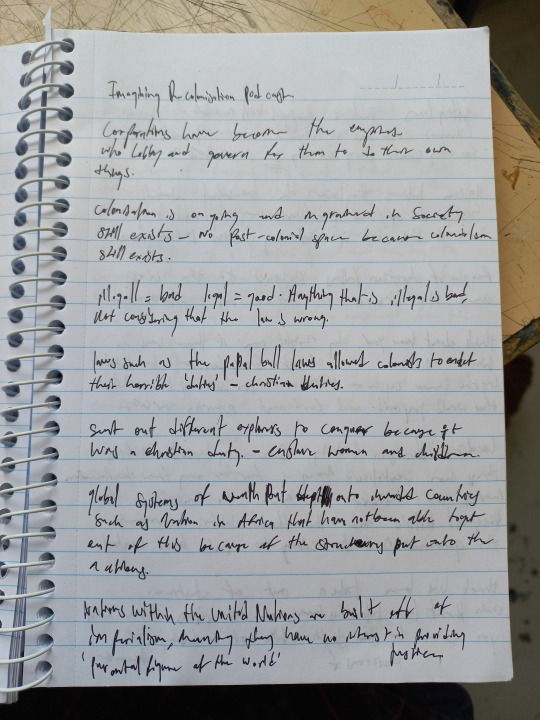
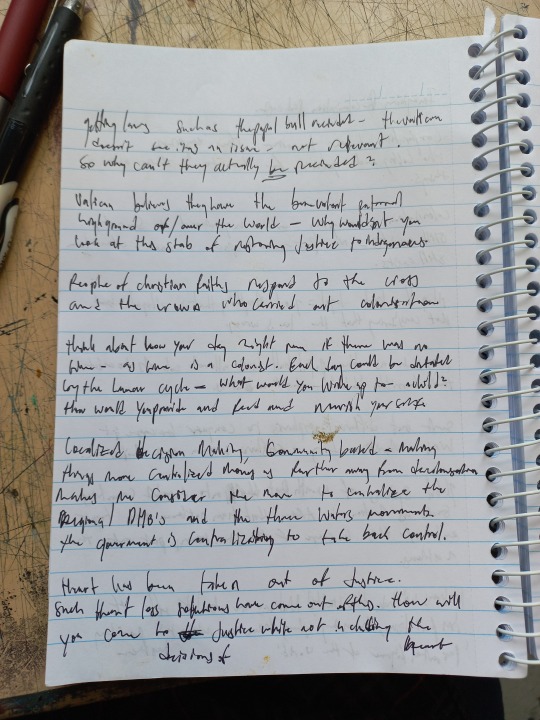

0 notes
Text
week 5 colonisation and decolonisation
notes from what we understand colonisation and decolonisation to be
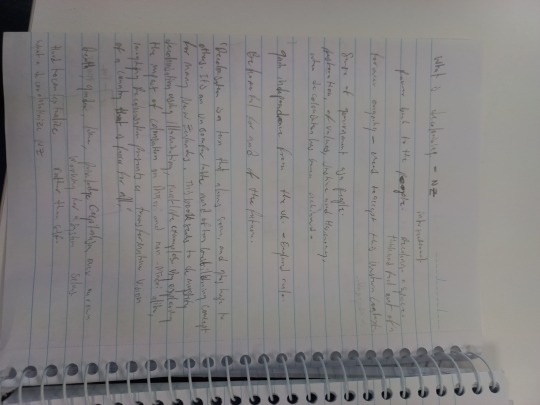
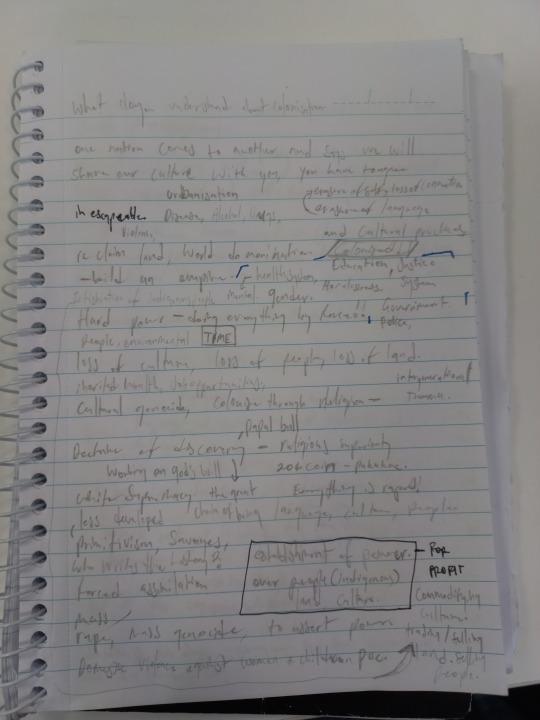
notes from dr moana jackson's talk
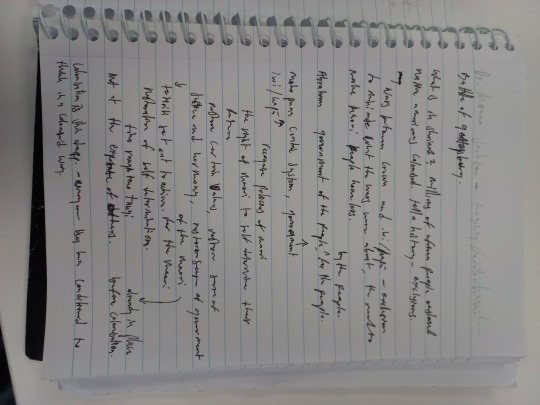

0 notes
Text
week 4 my matariki book
things I like in my book I found !!
while researching matariki, I found it increasingly difficult to find any information beyond surface level stuff like what all the stars stand for and why matariki is important as a national holiday. So going to the massey library i picked up this book by libby hakaraia which goes a bit deeper into things related to matariki. really good resource for this class!!!
notes on some of the pages
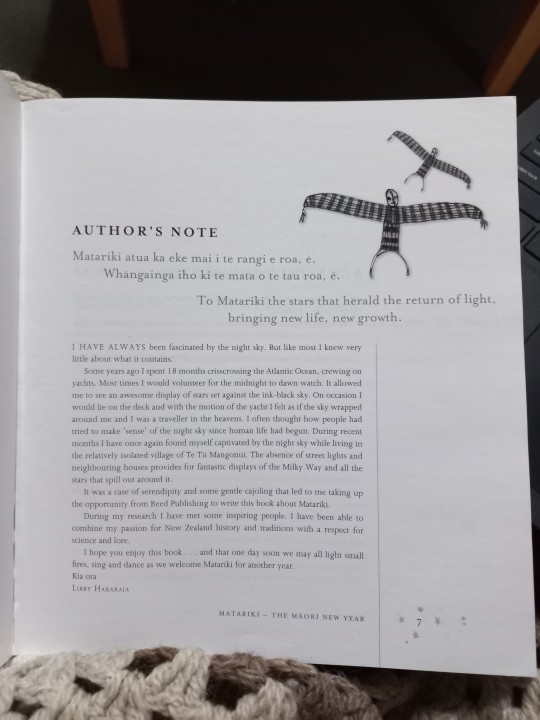
author's note - just thought it was a sweet message about why the book was written - it's not nessarily to share all information about matariki but it definitely helps to expand knowledge on different bits about matariki.


my pages where i found out about mahi whai and used to then inform my artwork!!!!! really interesting pages and story. this is also the same guy I found a video of on youtube chatting about mahi whai. he outlines that it's a form of keeping knowledge for people of all ages - not just children.

this page tells me about how matariki was important in different ways; measuring time, navigation, crop and food growing.
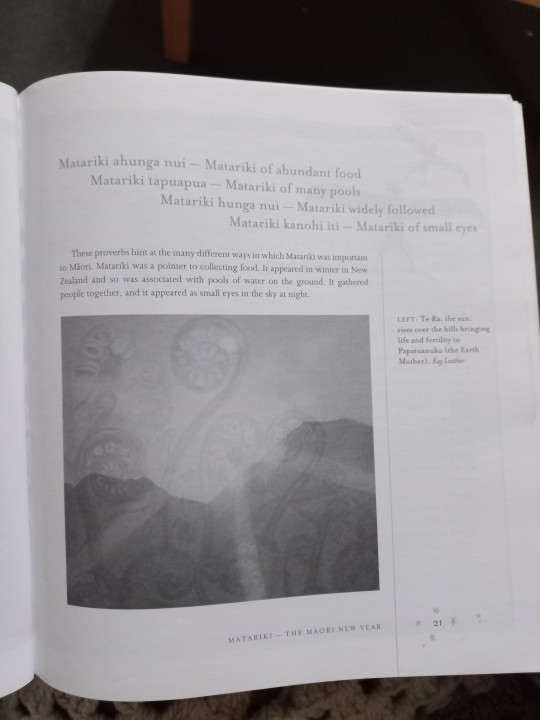
proverbs help to share what maori believed matariki to be about - the myth of where it came from too.
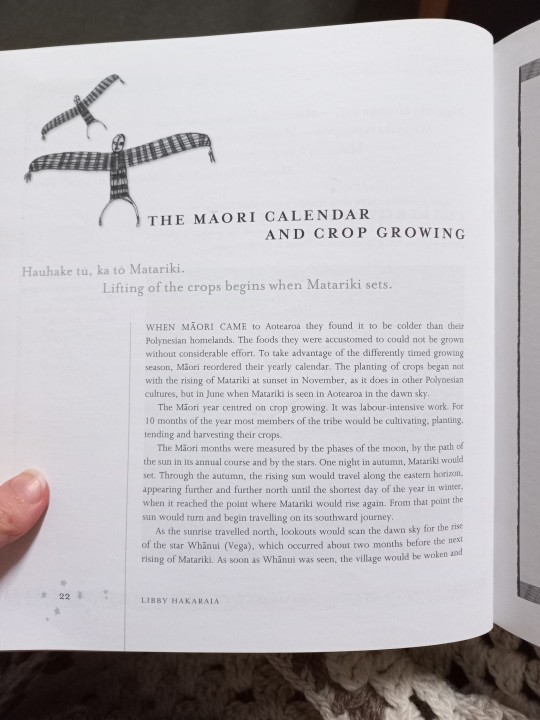
this page was really helpful because it explained further why maori believe matariki signals the new year - all because of crop growing. and about how the maramataka works - a lunar system in collaboration with a environmental. makes you think about what will happen to all these systems as climate change gets worse and changes the environment.

im not sure which months are supposed to be the 'extra two' in the maramataka but i think it's a really smart idea to allow your community time off to spend doing things other than working to make food!! (working to survive) you instead can give them time to relax and talk and make and build skills.
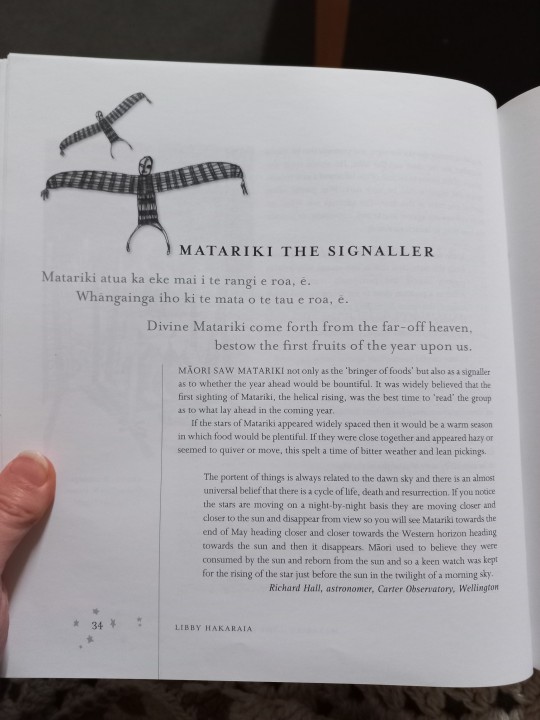
i like this page because it outlines how even just the look of the stars had an impact on how the year to come would be - or at least they thought it did.

i think the pleiades is the other most popular name for the cluster (other than matariki) although i don't believe anywhere else in the world they view it the same way (new year) so it might be the more common name for the cluster but i just never knew because i do not live there. also interesing to know more about pleiades and the names of all the stars. and how they are connected to other greek stories such as orion

never realised the subaru had the stars on the side of the cars !! also goes into a bit about the matariki cluster and how different cultures around the world view it

different names and beliefs of matariki across the world!! very interesting how many of these different cultures aligned the stars to be woman or signify women

another page/person that talks about the different iwi believing in different things and how you have to be careful when talking about it because it can actually anger them alot.
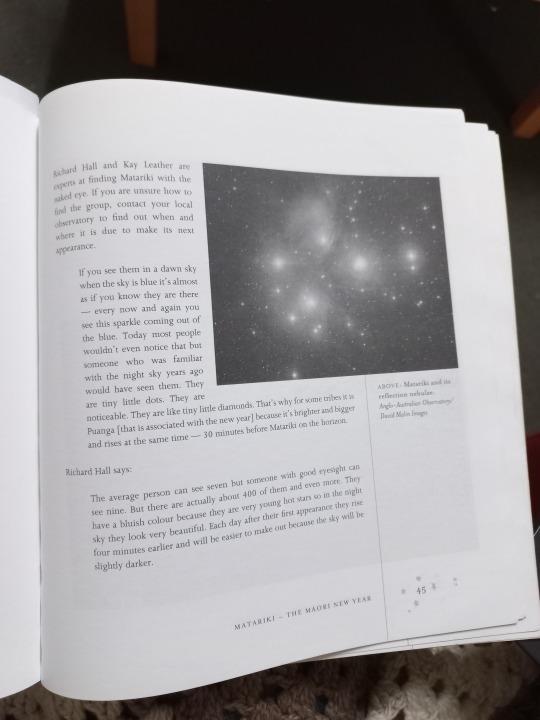
then they expand on how/why this is, eyesight, place on nz, height etc. explaining why different iwi's believe there are different amounts of stars in matariki.
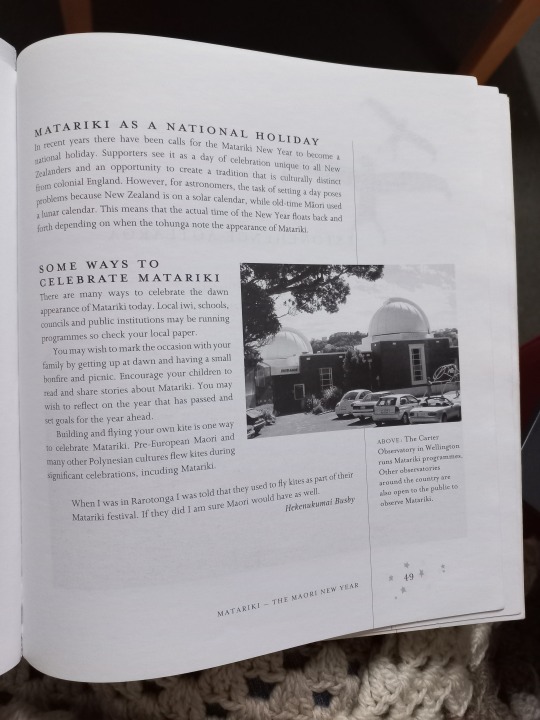
i find it really interesting that back in 2004 there are calls/movements about starting matariki as a nationally recognized public holiday. also found it funny the argument of the lunar calendar thing here when we already have easter, which also aligns with a lunar calendar system which is why it moves across march and april - so it's a bit silly to argue that a one day holiday would be harder to arrange than a three day holiday don't you think?

just wanted to note the emblem for the maori king movement again - which i also found in another book. obviously matariki was important to them and their iwi so they included it on their emblem. one notable thing is that there are only seven stars, could be because the iwi believes that matariki only has seven stars in the cluster (as some iwi/hapu do)

i like the connection of matariki to other mid winter celebrations like winter solticles etc. also how this quote already outlines how matariki is a celebration for everyone - not just maori (book came out 2004)

i liked this poem, reflects on how the new year is celebrated in maori culture vs western with friends and drinking vs with family and connection. puts into perspective how different each culture is and how this has affected time based celebrations such as a new year.

just a good page to tell you about what the maramataka looks like in comparison to the gregorian calendar we follow. same as giving you the maori names for the seasons and for the months. although I think that because the maramataka is based more on lunar/environmental factors the months don't lie up as nicely as they do here.
0 notes
Text
week 4 making art
just gonna write some more notes on the piece I am going to make.
I love printmaking and while researching I want to reference the maori concept with carving from wood "to reveal the essence of the form". which in a way I do not agree with for the piece that I want to make - because I am using mdf which has no form it is made from mushed up bits of wood into this thing, so it really only has a form if you make one out of it. The only form it takes on is the one you give it, that is the purpose of why the material is made so that is what you give it!
my piece of wood is 300x300mm so I could make a 4-board multi-block woodcut from the 300x300 dimensions, each being 7.5 cm squared.
but I need to think about if I have enough ideas to make a 4 block print or if I only have enough for 3
my plan!!


so the idea is that we will be able to see stars of matariki kind of through the strings - mahi whai is a way of passing knowledge on to younger folk through the strings yknow, so how about as young people they use the strings to see the stars as if it's a way of magnifying/explanding their knowledge - as the strings are held up to the sky the stars become more visible !!
so i will need to teach myself how to do a string pattern, I found this video of the same guy who is from my book but he is speaking in maori and you cannot see his hands very well so I do not think it will be super helpful which is really unfortuante because I would love to learn from him!!
youtube
but I found another video on how to make a seven diamond pattern which I am most interested in ! (because 7 diamonds for matariki).
youtube
while trying to look for a string pattern I find it really interesting how it keeps popping up that patterns are from different cultures. like a lot of indigenous cultures around the world have come up with ways to play with string. I even remember some time ago in primary I knew how to do one around someone's wrist that could actually undo and then not be around their wrist!
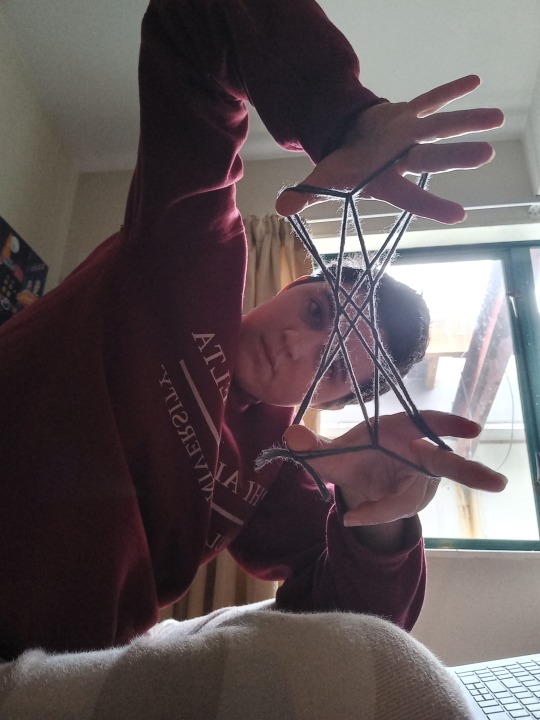
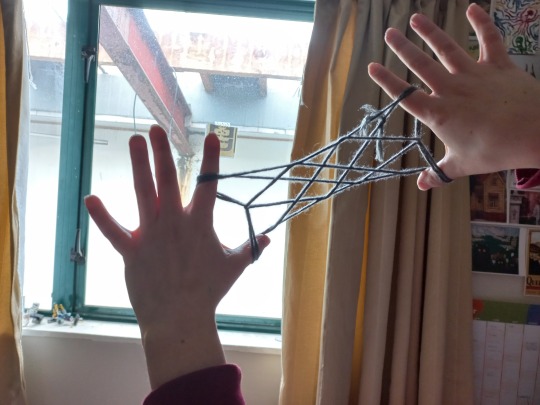

images of me trying to learn the pattern (was not turning out for a while) and then my final image to use as i figured it out!!!
0 notes
Text
week 4 independent
task 1
Reflect: Have a look at your responses to the independent study from last week.
How did this weeks class discussion deepen or help develop and expand your initial understanding? You could write about this in a sentence or two, or you could go back and add to your original notes.
I have already added to my notes already but I will scribble a little more here, I like the concept and I like learning deeper or more about the concept rather than just being told something is tapu. It's really interesting to learn that there is a reverse of tapu (noa) and that it is equally as important for explaining the world around you. Now knowing that something which is tapu has spiritual significance in terms of like (my best relation/thought is karma) makes sense to visualise it, if you forbid (?) break tapu yknow something bad will happen to you - but that is only in certain examples, in other examples doing something that is considered tapu is actually just kind of gross and unhygeineic, which is why the reading was really good for like grounding the concept for a person like me (pakeha centric worldview/lens). Things that are tapu are not just related to spirituality they are also just common sense hygenine in some ways.
Task 2 (2 hours) Self-directed study on your first assignment WRITE and MAKE: Continue self-directed work on your assignment. Refine and revise your writing for your definition and your contextual understanding, bring these to the next class. Begin trialling, testing, drawing, producing samples for your practical component, and make a plan of what you will need to do to complete this component.
i will add my definition here, in class we got shown a couple of examples so I think I am feeling a little better about it, worried about my quotes and if I have enough understanding to be informed enough but I have faith in myself - I will be okay
DRAFT;
Matariki is the celebration of the Māori new year. It is a time to reflect, celebrate and prepare for the year to come. Matariki is the name given to the cluster, depending on your iwi you may see 7 or 9, some even only see 5.
Communities gather and mourn those we have lost in the previous year, calling their names as the stars rise. believing that as we mourn we release their spirits for them to become stars as well. As you view the stars maori look to see how the year ahead looks, depending on which stars are brighter could mean a beautiful harvest from the sea or from the sky.
Only is it in recent years that matariki is having a resurgence;
Renaissance (hit this idea)
beginnings and endings, coming together, remembrance of the dead, and traditionally, the planning of crops and planting.
The maori use matariki as a way of predicting when to plant crops. As it is a part of the maramataka.
Having matariki be promoted to a public holiday has opened the celebration to anyone all over nz
believing that as we mourn we release their spirits for them to become stars as well. As you view the stars maori look to see how the year ahead looks, depending on which stars are brighter could mean a beautiful harvest from the sea or from the sky.
story/myth of matariki
Māori respect nature and feel a deep connection to the land, sea and forests. They believe the rhythms of Papatūānuku (Mother Earth) can be understood by reading the Matariki stars and phases of the moon.
which help to dictate the maramataka.
Each of the stars in matariki mean something special (go into this)
What each of the stars mean
Find quote on the meaning of the stars or maybe how science is magic.
Para 2 - the stars as a whole what each mean.
Each of the nine stars have their own meaning and connection to something on land
Most importantly matariki was a pointer, it let maori know when to take crops out of the ground
“in the evenings, you only had the night sky to look at, and stories to tell. That over generatons, stories built upon older stories, certain people with partcularly clear vision saw paterns in the night sky, or notced movements.”
(task 3 is missing)
Task 4 (3 hours)The following three resources introduce you to key ideas and examples about the role of language in shaping the way we see the world. Choose 1 or 2 of the following:
WATCH: Jamila Lyiscott's discussion about language and the use of language in relation to identity and community. THIS ONE
READ: Tatauing the Postcolonial Body by Albert Wendt. Wendt peels back the language of tatau in Samoa to show the deep connection between the words and cultural practices and beliefs. THIS ONE
READ: This excerpt from Robert MacFarlane. McFarlane focuses on changes to the Gaelic and English languages, and its relevance to the landscape.
CREATE/REFLECT: While these three resources are from different cultural paradigms, each addresses situations akin to 'upholding the mana of language'. All of these resources are also written in a more poetic register, than what is usually considered the 'norm' in academic writing. Write a poem, or some poetic prose drawing on what you've learned from the various resources about language this week.
jamila - after having watched Jamila's tedtalk I enjoyed it, its what I think slam poetry is (in a way). I like how she is using her voice in different kinds of tones to convey the different languages she speaks/is surrounded by while always having to speak the same one - english. I find it super interesting how much rasicm (but backhanded/quiet) comes out when it comes to language. seems unfair that just because of how you look you are expected to be inarticulate or unable to speak the same language.
An idea that really interests me is the loss of language through slavery, all of these people who were forced to the states do they remember anything of the language their ancestors spoke before? was it forced out of their communities so they had even less to rely on and share, were they forced to learn another language etc etc until it is lost and thwy have to assimilate to another culture and another language which they choose to make their own in one way or another.
they in a way create a new culture through the language they speak.
Albert Wendt - Just because of his name and not knowing the guy I went most of the way through before realising that he was also samoan and not just some guy who was really interested in tatau. SO after realising it was much nicer to read from a person who's involved perspective - I especially liked his line "What I've just demonstrated by looking at the meanings of the two keywords is to say you have to be bi-lingual (Samoan and English) to better understand post-colonial literature. You have to know the indigenous language and culture of the writer producing that literature in English".
from him (which is a point I agree with) that in order to understand the topic that involves another culture/language you must understand it in it's first form and then also in english. I can imagine it would help as alot of countries were colonised by england to understand english and depending on your country what english is - how it is spoken. Yknow because in aotearoa we speak with so much slang and dropping of our vowels compared to other countries where they overpronounce consonants.
which really means the only right way to understand how indigenous practices were affected by colonial structures in aotearoa is to understand both english and maori. there is no ability to understand something like te tiriti o te waitangi without understanding both english and maori. Even though we have our two versions they do not mean one and the same.
Anyway I also read this one because I am interested in tattooing and to know more about tatau in an indigenous sense. I am surprised at how intertwined with samoan tatau the idea of pain and managing / surpassing it is. To be tataued is to experience and live through the pain. Yet it seems that beforehand you have to earn the right to be tatau-ed through responsibilities etc.
okay little preface on this I do not do very much creative writing and I have never written prose or poems that are any very good. Because I know poems have no rules I break all of them and then just make bad poems, but notheless i will try my best (just saying don't expect anything exempleary)
prose/poem ::
spanish class
all this reminds me of my high school spanish classes.
we learnt of christopher colombus and the new world
how his discovery brought a language and a regime of christianity to a continent full of indigenous peoples.
all based on the doctrine of discovery
all this reminds me of the demise of indigenous language
Silbo, Quechuan, Aymaran, Tupí-Guaraní, and Mapuche
not gone, still spoken, but missing from the noise of everyday
there are questions in the world about if we all spoke the same language
all this reminds me of what ?
would we choose to speak,
would it all sound the same,
would you choose to understand.
all this reminds me that language is culture
culture is language
language is shared through culture
and culture is shared through language
all this reminds me is that one cannot exist without the other
culture is built off the language you share
the meaning the words have
the symbolism of your words
all this reminds me that
i have the priveledge to learn a language for the desire
I have the priveldge to have been born speaking and understanding
yet when they learn my language they do it to survive
0 notes
Text
week 4 te reo Māori and te reo pākehā
this weeks class we did have about over half the class missing because of the quarter-final game that is on for the fifa women's world cup at the sky stadium today so! there was not a huge amount of discussion in class (I would say)
Discussion: In groups reflect on your independent study, including your reading around mana, tapu, and noa, and the design examples you were asked to find.
How might you think about this in relation to language, and the preservation of language?
How do you see language being linked to design and art, in general?
we did not discuss this or if we did I did not realise, I was the only one in my group who did the reading so I described to them as best I could about how tapu is spiritual and belongs to every living thing - that if something it tapu it was meaning, it can lose this meaning, significance and become noa, which is like any normal thing
“Ko tōku reo, tōku ohooho. Ko tōku reo, tōku mapihi maurea.” (My language is my awakening. My language is my treasure)
This whakataukī refers to the importance of the revitalisation of te reo Māori, after the systemic attempts to erase te reo Māori as part of the colonial project, through mainstream schooling.
Watch: This week we will be watching Tame Iti's (Tūhoe) kōrero on mana in relation to language, art, and protest, and having an in-class discussion about the broader implications this has for understanding culture's intersection with language, design, and art.
Reflect and discuss: After watching Tame Iti's kōrero, consider the following:
What did Iti say about Mana, which might help in terms of your assignment?
How might you think about Mana in relationship to the artworks and performance-pieces he describes?
What relationships can you see between Mana and language, in general?
What might some of considerations be when upholding mana tangata in relation to the fields of design and art?
as like a pakeha artist in this space, we need to be careful in like our place and our privileged because of the system and society that we are in that discriminates against others because of the way it as built by the damn colonialists. it's important to uphold mana and the people who's stories we are retelling - this is not our original whakapapa so you have to respect those who came before. uplift them and their knowledge because it is theirs.
thinking about like cutural appropriation in this space and relation to this i think of the powhiri framework with our studio classes. I find it really really odd. Like I appreciate learning more about the different stages and why each part of a powhiri happens (and it's importance) but i feel really at odds that the university has taken this maori ceremony and made it about something else?? Like I don't quite think I have the words to explain it beyond that I feel weird about it at this point and time.
my notes from the video!!/group discssion


and then we did not watch the second video because we instead just got to talking about the assignment - what it wants from us (because the breif is very confusing and I do not understand and neither does anyone else)
so next week when we watch it I will add my notes on the video here :)
ADD NOTES FOR 2nd VIDEO HERE
In groups discuss how Dunn's TedTalk deepens your understanding of Whakapapa.
0 notes
Text
week 3 doctrine of discovery presentation
And here is an excellent presentation by Malcolm Doidge that explains the implications for The Doctrine of Discovery and Native Title here in Aotearoa
notes from the presentation
‘Native title’ is defined legally as indigenous people’s right to assert ‘ownership’ of customary resources citing their occupation of land prior to European colonisation.
so by this I don't really know what the terms would have been for maori before this, because arguably the maori were settlers as they came from Hawi 'iki but then you can go on and say well before Hawi 'iki they cam from here and so on and so forth because that is how humans evolved. so in a way everyone is settlers but not everyone is colonisers, so I guess I'm trying to I find native title a weird term.
The Doctrine of Discovery is an international legal concept and Christian principle, that is borne out a number of catholic laws (called “papal bulls”) originating out of the Vatican in the 15th and 16th centuries. It gave the monarchies of Britain and Europe the right to conquer and claim lands, and to convert or kill the native inhabitants of those lands. https://tinangata.com/2019/06/01/james-cook-and-the-doctrine-of-discovery-5-things-to-know/
which to me is pretty crazy, but of course I am born into the 21st century when all this stuff has been explored and abused and now have the access and ways to understand it and how dangerous it is as a piece of common law. It is also shocking that the pope had more power and rights over kings and queens of nations to be able to make a law like that.
also shows how deep racism goes/white supremacy/christianity supremacy with lines in the doctrine like;
The Doctrine of discovery held that land not inhabited by Christians could be claimed, while "barbarous nations be overthrown and brought to the faith itself."
what makes a nation barbarous though? Whos discretion is that up to? why is it only one person who can decide this? but then this was the past and they cared less for others who did not share the same faith or skin tone.
Unlike Australia, Māori customary rights and usage of land take precedence over the Crown but only where these have not been legally or ‘expressly’ extinguished by the Crown - i don't really understand what this line means, the only thing I can really comprehend is that it could be referring to the fact that sometimes the crown has leant on the doctrine of discovery in uk law
so weird all of it.
0 notes
Text
week 3 practical piece
WRITE: Continue to research your project. Select your final example and write up your contextual understanding of this, making connections to the definition you drafted last week and continuing to use course resources and your own further reading to help develop depth and nuance in your discussion (use the Massey library databases). Make sure you cite your sources as you go.
LIST, SKETCH, MAP or PLAN: Sketch, map, plan ideas for the practical component of your assignment.
there is so much stuff on matariki on stream it makes me very overwhelemd to be honest, because I know alot of it says the same stuff as well so that concerns/stresses me out about which to read and reference yknow. also i am so confused this breif is horrible and I hate that there is this thing that I am already supposed to have completed when the concensus is much different in class!!!! evil evil stream.
so i think i will just document on this workbook for now that I am learning and doing stuff, because right now I do not understand at all what I am supposed to be doing through stream - or it makes it sound like I should be much further along than I should be which does not make me feel very good.

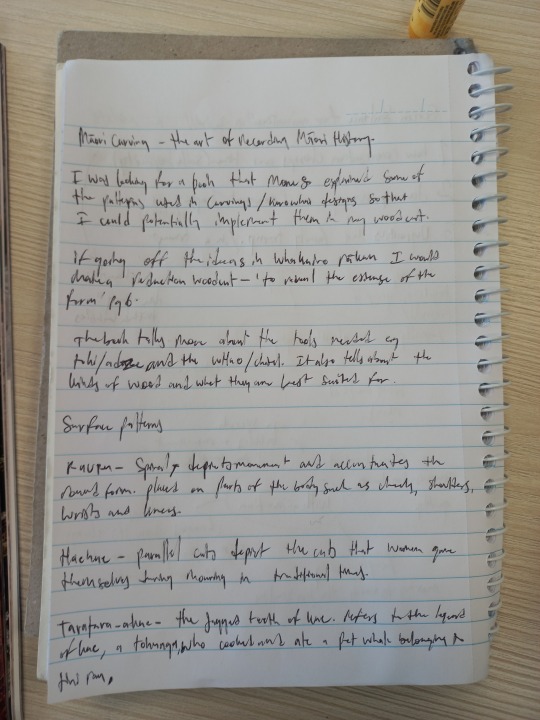

some notes I took from the book!!!
also a website I found on some patterns and what they all mean - albeit a very simple one so maybe not what I will go with.
in refernce to how the maori work when it comes to a carving, i will most likely make a reduction woodcut "to reveal the essence of the form". my piece of wood is 300x300mm so I could make a 4 board reduction woodcut with the one major board, each being 7.5 cm squared

sam farquhar (Te Ati Awa, Ngati Rahiri)

Cliff Whiting
In Maori mythology, Uenuku is the god of rainbows, and is also a Maori ancestor who lived in Hawaiki.
I like the framing of this one, the only thing is I don't like working with people/faces in my work, I could do a hand or something?? I think I will look further into the hands and the rope thing


I got this book out from the library about matariki, it goes into mahi whai and the significance of the string games as a way to tell stories. the shape of the strings for example can be used to shoe matariki
0 notes
Text
week 3 independent
task 1 (5 mins)
Reflect: Have a look at your responses to the independent study from last week, how did this weeks class discussion deepen or help develop and expand your initial understanding?
i think I already had a pretty good understanding of whakapapa and how it is not just about your family and ancestors and lineage but also where you can locate yourself to a location. Whakapapa directly links to whenua and being from the whenua, using the example and being able to unpack/explore some of the terms like mana whenua and tangata whenua also help to expand the idea of whakapapa.
whakapapa is all about how you connect to one another through your lineage and connection to this land because it matters to honour your ancestors and where you have come from it is just as important to know.
yknow whakapapa refers to the interconnected-ness of everything and how it all relates back to the whenua. So removing a part of what makes it whole takes away the whakapapa.
Task 2 (3 hours)
Read: Ataria James et al. "From tapu to noa: Māori cultural values on human biowaste management: A focus on biosolids" The main example in this reading is the management of biowaste, choose an example of your own (this could be an object, person or space) and draw an annotated diagram that outlines considerations between tapu and noa that might concern your example.
Try highlighting or underlining just one sentence or phrase (the one you think is most important) in each body paragraph to help break the text down.
HIGHLIGHTED SENTENCES!!!
abstract;
The tapu and noa constructs work in conjunction with other values to govern human behaviour and relationships with the environment at any point in time. However, tapu and noa are not fixed and can change through time as a result of a specific action or consequence; thus influencing the ability to interact or use an object or resource which create interesting management implications for human waste.
introduction;
Tapu and noa are fundamental traditional constructs in Māori philosophy and spirituality that once governed the societal infrastructure and continue to have application and influence in contemporary Māori society.
understanding tapu and noa;
This deeply religious connotation coupled with an unyielding commitment to and belief in the power of that spirituality is why tapu was such a powerful instrument in traditional society (Harrison in Benton et al., 2013:410) and continues today.
This implies that the tapu of separate objects does not exist in isolation, and more importantly different aspects or levels of tapu will interact with each other resulting in outcomes that are either constructive or destructive in nature.
That something deemed ‘ordinary and safe’ is also bestowed with ‘randomness’ and ‘uncertainty’ seems contradictory, hinting perhaps at the flux and tension between tapu and noa as permeable and entwined.
Other foundational concepts of Māoridom – such as mana, utu, mauri, whakapapa and manaaki inform the expression and understanding of tapu and noa under different contexts. The balancing and appraising of tapu and noa in relation to these important multifaceted concepts helps inform tikanga as protocol that guides appropriate or best practice (Figure 1).

tapu, noa and human biowastes
The rationale for use of karakia and other customs associated with the separation of various types of human waste in the living arrangements of a traditional Maori village was passed from one generation to the next through archetypal stories of prominent ancestors such Hema, Tawhaki, Rata and Hina (Hineteiwaiwa).
This elevated tapu state demands that prescriptive procedures and processes are implemented to avoid instances of extension/consequence where the tapu associated with biosolids creates a destructive outcome when it interacts with tapu from another entity/thing.
The notion of tapu and noa as being transitory, introduces the prospect that things deemed tapu could potentially change their spiritual state over time – assuming that the requirements of time, a detailed knowledge of the composition of the waste stream and the appropriate cultural and management process have all been satisfied.
contemporary expression and manifestation of tapu and noa
The impacts of colonisation have marginalised Māori participation in decision-making relating to natural resource management processes – although this is changing rapidly with Treaty-based legislation and the changing power dynamics following Treaty settlement.
Designed to facilitate effective and timely removal of hazardous waste away from built up areas, these systems commit communities to a specific model of treatment reliant on existing infrastructure. While these systems are effective, management of them could be improved to meet cultural concerns.
This is impossible to achieve with modern reticulated systems that process wastes from multiple sources. There is less ability to control and be certain of what goes into the system, treatment processes, more diverse cultural practices, increased volumes and an ability to transport waste to other locations
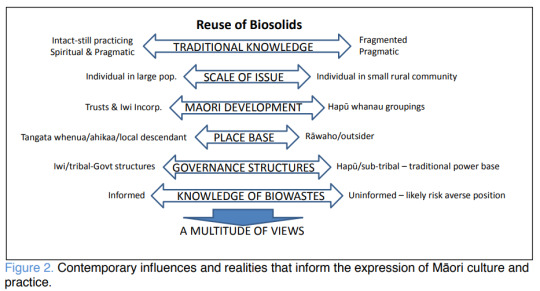
co-management to reflect traditional and contemporary insights
in the paper these points are already summarized and bulleted so i will just choose some of the most important
Some expressed ‘not feeling comfortable’ as a way of articulating how use in the food chain sat uneasily within the frameworks of cultural knowledge and practice.
There was a healthy tension and active reflection between traditional ‘separation’ of human waste from food, and being pragmatic and ‘moving with the times’. Some talked of ‘longdrop’ sites ‘being covered up and don’t go near it’ and ‘not used for anything else’ for 20 plus years.
Māori productive sector businesses, for example, were willing to explore biosolids reuse as ‘hypothetical’ in future planning for sustainable on-site waste management systems, but they were also concerned about how beneficial reuse might impact on export markets, branding and commercial sensitivities around their food production.
Methods of treatment that employed natural processes like composting and vermicomposting (earthworms) were considered favourably, but concerns remain about the ability of these techniques to treat chemical contaminants (recalcitrant and new and emerging contaminants) and what were appropriate reuse options for the composted product.
conclusion;
Today it is far more difficult to control what goes into the wastewater system and where it is treated and disposed of – especially where households are connected to a reticulated system. This is due to legislative and policy requirements and the complex ethnic composition of New Zealand communities.
Tapu and noa are Māori cultural concepts that operate alongside other concepts and values to inform traditional knowledge and resource management frameworks. There is a breadth of cultural knowledge on the topic of biowaste, biosolids and wastewater management, a willingness and openness to explore new forms of co-management, and an expectation of being involved in decision making.
for my example I wanted to look into a person, notably my great aunt janet who I have met a few times when I was younnger but cannot recall anything about or any conversations with. I have been looking a little into how maori treat their kaumatua and thinking about this in relation to tapu and noa and also western/my feelings towards my elders. from te ara https://teara.govt.nz/en/kaumatua-maori-elders/print it says this of kaumatua
Kaumātua were probably the most influential people in the upbringing of children. The relationship between elders and children was generally characterised by care and affection with appropriate discipline. Te Rangi Hīroa (Peter Buck) recalled: ‘When I was told that an aged visitor whom I had never seen before was a tipuna to me, my heart warmed towards him. I placed him in the same category as my other tipuna who resided in the same village and had lavished affection upon me. He was a member of the family.’3
now to my aunt janet I am not a mokopuna, I am her great niece but notheless she is my elder and I jut wanted to express I do not feel this way towards her. I feel in some ways because of the western cultural lens/environment I grew up in I feel there was (for me) not as much encouragement to respect or learn from your elders from a young age. Thus I know next to nothing about my great aunts and uncles other than their names and basic knowledge, I never see them and I am never encouraged to interact with them.
I have a feeling I am misunderstanding some of the ideas/concepts around tapu and noa but!! I am trying to relate these concepts to an experience I have recently had with an elderly member of my family - so as I understand it Kamatua have so much knowledge and wisdom that they then have tapu and mana, because of this I feel there is a certain way to act around them that is 'correct' cannot ask certain questions, can only touch certain topics, etc.
I think this topic is too hard to articulate and I should make it simple for myself so instead I am going to look at when my Uncle died.
he died in his own home after a long time of dealing with pancreatic cancer, he had hospice care from home and died while sleeping.
the next day his body was in the living room in a tangihanga setting. Both my aunt and uncle had been involved with learning maori and practices through night classes and had made some pretty strong connections with some iwi in Greymouth.

i do not think I have fully understood this notion of tapu and noa in relation to other things. Without examples such as the biowaste I struggle to make sense of it in terms of other things or people. !!!!
my brain is not working right now but after class and having holly talk about how it's tapu to wear shoes inside you kind of only really truly acknowledge that after realising some of these things away from their source - like yes it is actually gross for hygiene purposes to wear shoes inside not just because it's linked to something spiritual that we should all honour.
catherine also said something about tapu and noa in class that made me go damn I misunderstood all of it but yknow what thats okay I tried my best and I am still on a journey of learning!!! - also fun to learn deeper about concepts. that i have in one way or another always known about.
notes from discussion in class about tapu and noa

0 notes
Text
week 3 tangata whenua notes in class
first of all in class we reflected on the homework - catherine realised her mistake in telling us not to read the 18 page reading now since I only did a half baked method of the reading I do not have as much understanding as some of my peers who read much more (in terms/context of the article Mere Roberts (Ngāti Apakura, Ngāti Hikairo). et al. Whakapapa as a Māori mental construct: Some implications for the debate over genetic modification of organisms.)
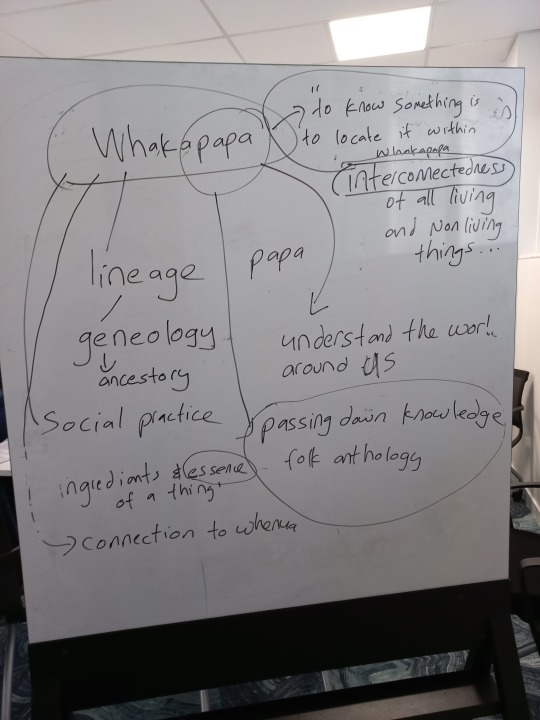
reflect/mindmap about what is whakapapa
we had a brown piece of paper that was really hard to read because we used both sides of it to do mindmaps!!!! so I do not have a copy of that photo but we were basically asked
what is whakapapa
and in our group we said well whakapapa is relation to the whenua (land) and mana whenua (people who are from a specific location) and tangata whenua (people of the land).
we also said its about lineage and geanology, being able to locate where you are from (which is where catherine gave us the work papa to mean layers (which links to papatuanuku earth mother and whakapapa))
we talked about how in terms of the kumara whakapapa as an idealogy is violated because the dna is changed which means you can no longer locate where it is/where it should be.
there was this quote from the article "to know something is to locate it within whakapapa"
whakapapa is something that applies to all beings, whether human or not human it matters on some level. because in western society we are so human centred our science is so removed from people.
Discuss: Now go back to the artwork your group discussed. How does this information extend or develop your initial discussion? Is there a key quote from the source that helps you make this connection?
our mind map on the lighthouse by michael parekowhai - it says/notes the things we discussed about the work, especially noting on the statue of james cook with the reflected stars which both he and kupe (and other maori navigators) used to be able to find their place in the sea and get to New Zealand.
talked alot about how the work references displacement to maori from their land because of colonisation and how in turn this takes them away from their whakapapa and then how the government then needs to build houses to help these people they have impoverished (is that the right use of the word)??
I liked hearing how the artist also views the work as taking up space in prime real estate as a way of fighting back through art. taking back his land and coming back into connection with his whakapapa (even though he is not from Tāmaki Makaurau) taking the land back on behalf.

Assignment preparation: Share the examples of design/art you found for your own assignment for independent study.
You can do this as a 'cold reading', that is; see if others can work out what key term/s from the brief they relate to, and what your key points about the example might be.
Or, you can present your ideas so far and give each other feedback on ways you could extend these.
Take notes of ideas, connections, suggestions that might help you extend your initial thinking around the example.
we did not do this.
0 notes
Text
week 2 more matariki research
I went to the library and had a look for some books about/that feature Matariki in them. Through Discover I found these books by Rangi Matamua although unfortunately for me they are all in Maori so without the assistance of google translate or a similar app I will be lost.
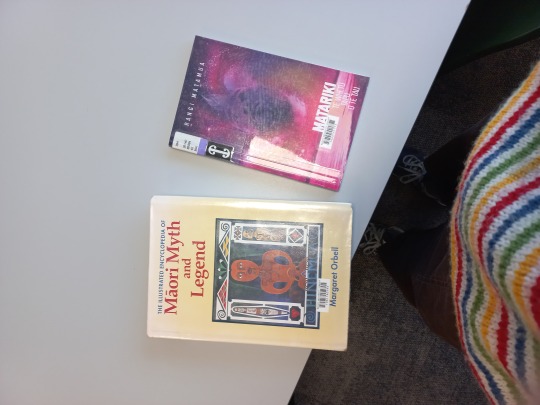
two of the books I read the maori myth and legend book gave a very brief over view but included (from memory it did anyway) this little section that had a coat of arms that included the stars of matariki.

with the matariki book by rangi matamua I did google translate some of the pages so that I could understand and get a bit more info off of a book rather than all online/through articles online. Also I haven't really found (or been looking) for any academic articles because I don't like reading them it makes my head hurt :)
here are some of my screenshots from rangi matamua's book
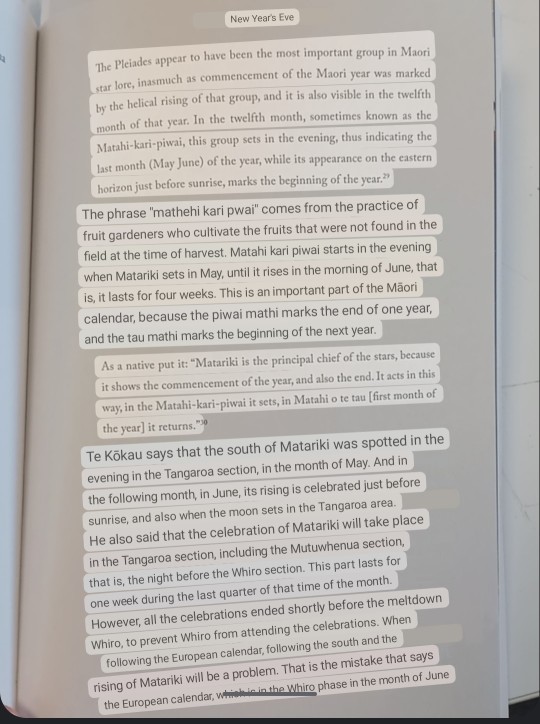




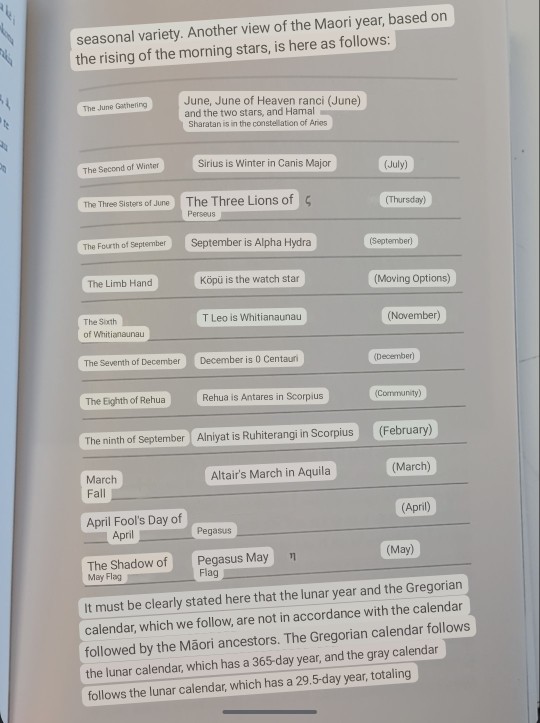
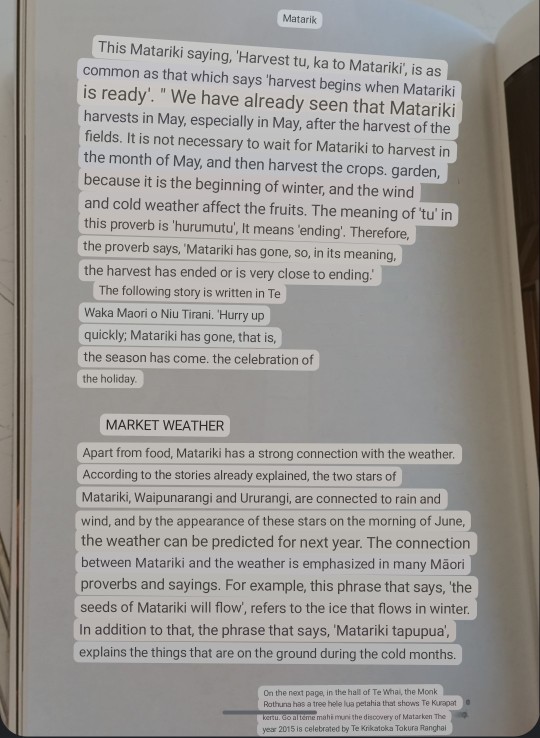
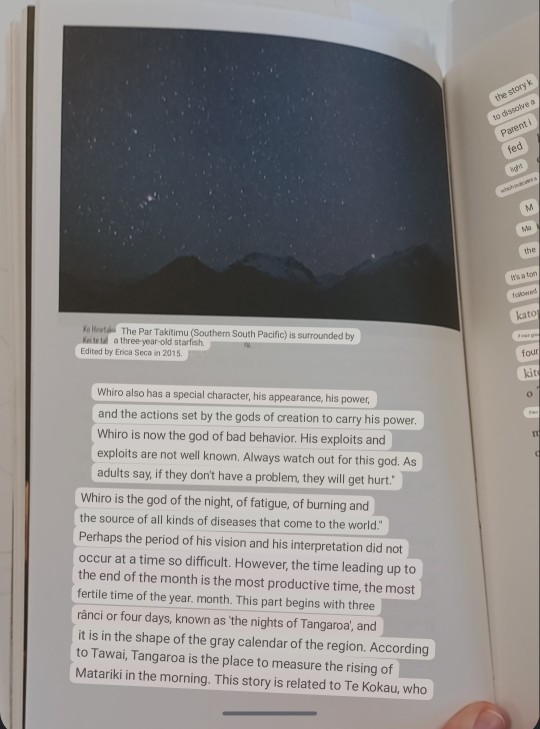
now because of course it is google translate it is not doing the best job of translating compared to what a human could do but! I think doing some reading on little bits can still help inform my knowledge and learning more about the subject.
0 notes
Text
week 2 independent extra work
Extra if you are interested (2 hours)
WRITE: Self-directed work on your assignment. Begin drafting your definition of the key term you have decided to focus on, using resources from the course and the Massey library databases.
Make sure you cite your sources as you go, so you don't have to back-track to finds these again when you have finished writing.
I am finding myself really drawn to matariki, my knowledge around it is limited so I think I will find enjoyment out of educating myself further. I guess i will decide which aspect of it that I am drawn to the most, so far I like the idea of decolonising the time, we live in a world based off of the gregorian northern hemisphere calendar, that makes no sense to the environment we live in.
I like this idea with matariki and time, how it calls upon those to spend time together with family, how afterwards it is encoraging us to take time off, but while researching I am finding things that I know I can relate to other things e.g this quote from dr. rangi matamua “I understand that there are tribal variations and differences, and that's awesome. It's meant to be different because we're different. I really support the coming through of traditional regional variations. My version has nine stars, because I can only go off what my ancestor says. If you have seven, have seven, if you have Puanga, have Puanga. And for Pākeha, accepting that has been a lot better, but Māori, we can get pretty territorial about stuff, like 'that's not what we believe'. That's the bit that makes me hōhā because that's not the point. The point is we celebrate it.” - which could be related to idea's in the Oxford History of Science soooo i guess i need to pick what aspect.
I could also go with how reading the stars gives us wisdom and tells us about the year ahead - wishing to different stars can mean different things, what all the different stars mean in my understanding etc.
FIND: 2 or 3 examples of art or design works that relate to the ideas you are discussing in your definition.
now I still do not know what it means exactly by ideas i am discussing in my definition because I have no idea if it does want me to have my own definition for matariki. but I have found a couple of works that respond to ideas of/around matariki. Alot of the pieces of art/design I have found personify the stars in some way rather than potentially relating to my definition, but I guess as I delve further I can expand my definition and this may become a part of it.
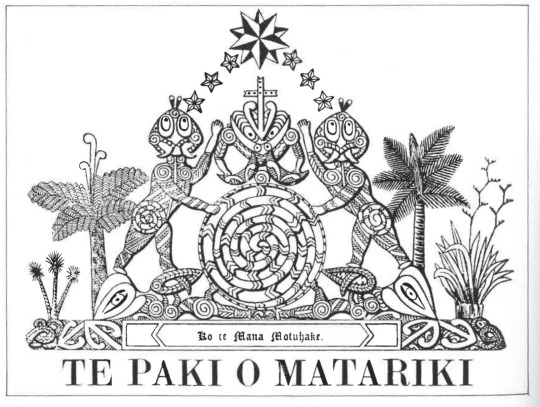
emblem made with the matariki stars
this coat of arms was requested by King Tawhiao in the late 19th century. it includes sevens stars of matariki and is also known as Te Paki O Matariki (the fine weather of matariki). This expression refers on one level to the the king's senior men whose support sustained the king movement.
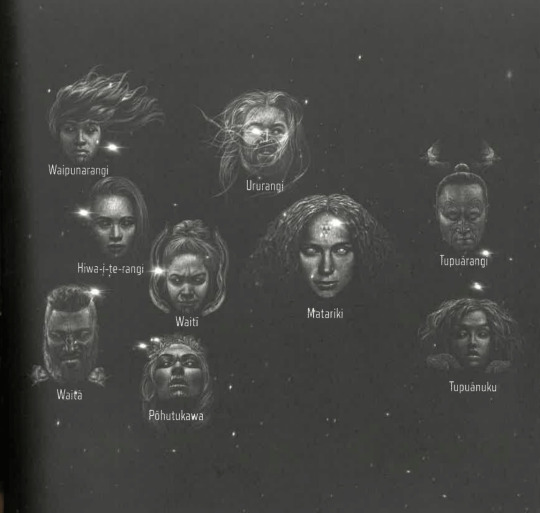
personified versions of the matariki stars
stars that were in rangi matamua's book and also in the matarki resources for 2023 (i cannot find who the artist/designer is)
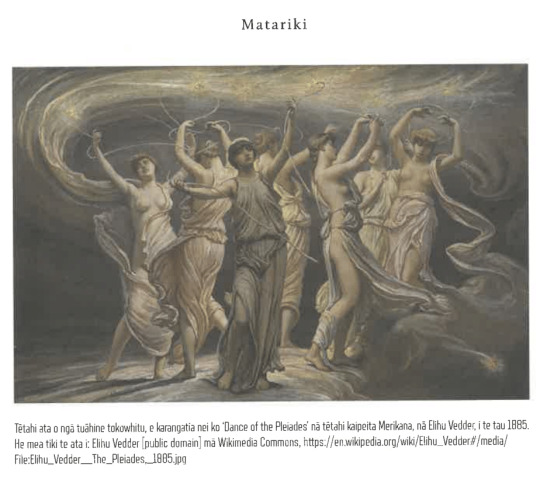
dance of the pleiades by Elihu Vedder 1885 - the name for matariki viewable in the northern hemisphere.
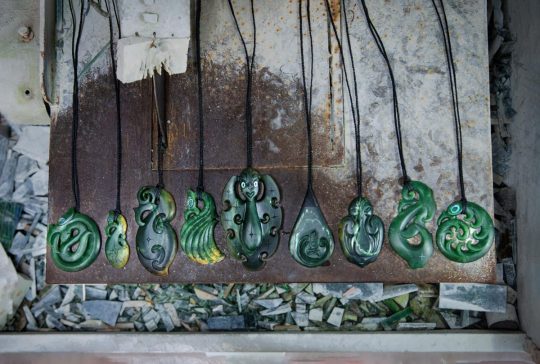
matariki pendants made by mountain jade
they were designed by Tamaora Walker and Akapita Scally, these absolutely beautiful taonga were made for the 2022 maori new year. Tamaora and Akapita drew on the concept of Kaitiaki. Known as a guardian kaitiaki are responsible for protecting something very special - similarly to the stars who stand for something and represents things such as food that comes from the sky or the earth or salt water or freshwater. Tamaora and Akapita took these concepts and ideas and created the stars as guardians of their element. they look beautiful and are finely crafted pieces of art.
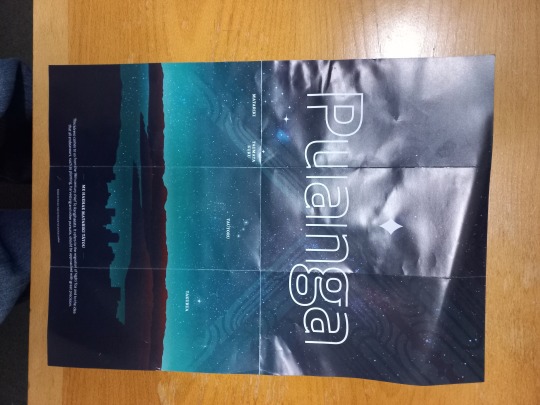
i can't figure out how to rotate this image its just a poster that got put in my mailbox. but this poster promotes puanga - the celebration of matariki. Puanga is a single star that appears in the evening sky shortly before matariki rises each year. Puanga rises higher in the sky than matariki so it's recognized over matariki by some iwi and hapu who cannot view matariki. This was designed by David Hakaraia and is referencing the view of Puanga and matariki from the ahumairangi hill. He says of the work that the sky represents a kereru, fat from eating miro berries preceding the rising of Puanga.
0 notes